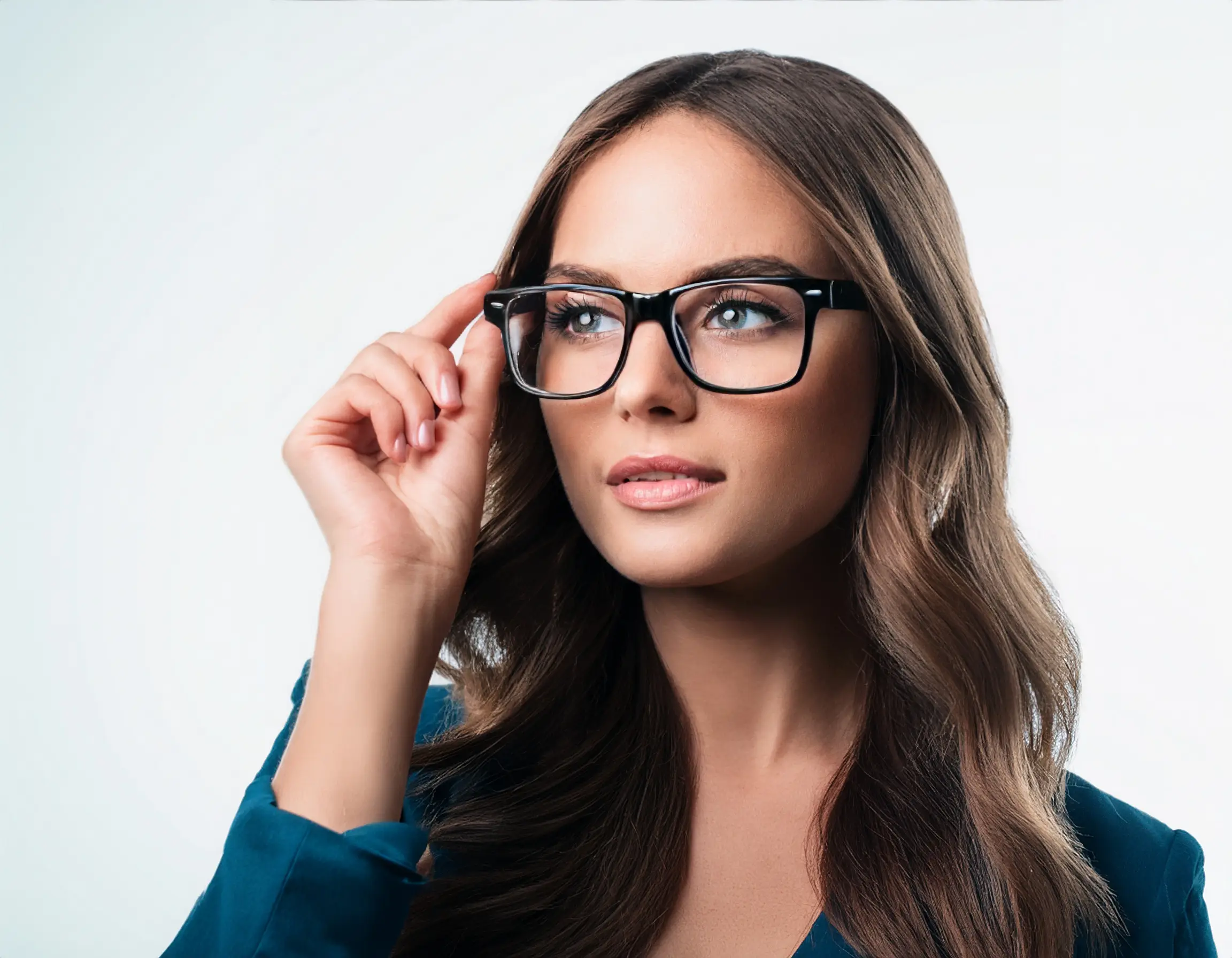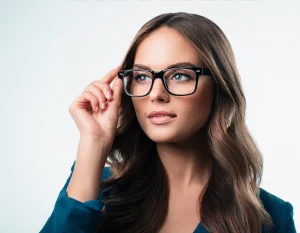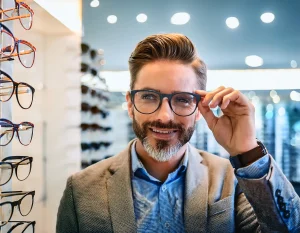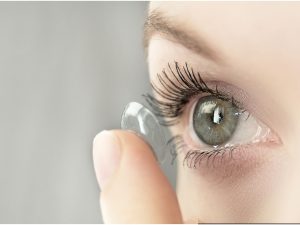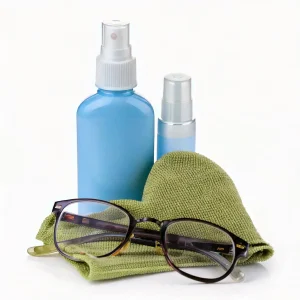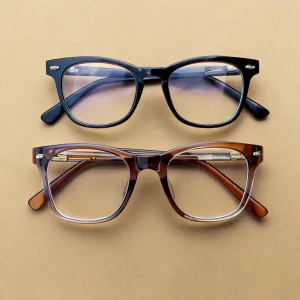Key Takeaways
-
By the way, 20/20 vision isn’t “perfect” vision. It doesn’t mean that you have normal eyesight at 20 feet. Reading vision is part of an overall vision picture that depends on what you do and how you live.
-
Reading glasses are a great way to improve your near vision and alleviate eye fatigue. They make near vision tasks like reading and using digital screens far more comfortable. They are usually designed for people with presbyopia – age-related near vision changes.
-
It doesn’t hurt your eyes to wear reading glasses with perfect vision. It will likely lead you to become avoidably reliant on them, and may permanently adjust your innate ability to focus over time.
-
Over-the-counter reading glasses aren’t going to be the best for everyone because they are essentially a one-size-fits-all product. Wearing the wrong lenses may lead to strain, headaches, or even lightheadedness.
-
Wishing you all great eye health and happy habits! Do the 20-20-20 rule, use proper lighting, and get regular eye exams to keep your vision clear and your eyes overall healthy.
-
Think about eye exercises, ergonomic approaches, and lifestyle adjustments to improve eye strain. These substitutes can help preserve your vision long-term while you wait on reading glasses.
It’s not wearing reading glasses when you have perfect vision that’s bad, but it’s not ideal. Reading glasses are made to help with presbyopia, a condition that makes it hard to see things close up, most often seen in older adults.
For people who don’t need them, using them can result in some discomfort and long-term dependence. At Premier Optical, we recommend consulting an eye care professional to determine if reading glasses are appropriate for your needs and to maintain optimal eye health.
Understanding 20/20 Vision
When we talk about 20/20 vision, we’re referring to a common benchmark used to evaluate how clearly someone can see. It’s worth pointing out that this is not the final word on 20/20 vision.
At Premier Optical, we believe in educating our clients about their vision, ensuring they make informed decisions tailored to their needs.
What Defines 20/20 Visual Acuity?
20/20 vision only measures a person’s ability to see at 20 feet. The very measurement is based on a two-number framework.
The first of these two numbers indicates the distance at which someone is tested, or 20 feet. The second number shows how far away someone with normal vision can see the same details.
For example, if you have 20/40 vision, you see at 20 feet what an individual with normal vision could see at 40 feet. Someone with 20/15 vision can see twice as clearly as normal at 20 feet. Everyone else is able to only see the same detail from 15 feet away.
This vision measurement is often measured on a Snellen chart, the standard ubiquitous descending rows of letters. This standard is very closely tied to distance vision.
It misses the bigger picture when it comes to visual health by ignoring depth perception, peripheral vision, and clarity for near vision.
20/20 Vision: Is It Truly Perfect?
For many of us, 20/20 vision has been peddled as the standard for perfect vision. Many individuals with 20/20 vision may still require assistance for specific tasks like reading, computer work, or other close-up activities.
Take even the stat that 68% of U.S. Adults depend on some form of corrective eyewear, which now incorporates prescription lenses to bring things up close into focus.
20/20 vision only tests for clarity at distance. Digital eye strain, dry eyes, and presbyopia can all dramatically affect visual comfort.
This is as true for people with 20/20 vision as it is for everyone else. This is exactly why regular eye exams are still so important.
Here at Premier Optical, we believe a comprehensive approach to eye health is the best practice. We make sure all angles of your DREAM 20/20 VISION are covered.

Reading Glasses: What Do They Do?
Reading glasses have a target audience of people who need a particular kind of vision correction. Basically, any adults developing presbyopia. As a natural part of aging, most of us do. This creates difficulty in seeing objects up close, such as reading text or fine print.
Reading glasses are not just a crutch to correct vision problems. They have a profound impact on eye health, and they greatly enhance the quality of day-to-day life for the people who wear them.
Functionality of Reading Glasses Explained
Reading glasses function by magnifying objects at a near distance, thus making them look clearer and easier to focus on. For people with presbyopia, this feature is a non-negotiable requirement for doing near-vision tasks such as reading, knitting, or typing at the computer.
These specs come in a variety of strengths, measured in diopters. They are precisely tailored to address the individual’s very specific vision requirements.
For people who already have great long distance vision, wearing reading glasses is simply not functional. Though perfectly safe to wear, they provide no additional benefit if your vision is already perfect.
For example, if you have 20/20 vision, reading glasses will blur your peripheral vision if you wear them when you don’t need to. Just make sure you choose the right non-prescription reading glasses for detail-oriented hobbies. They can be worn as a fashion statement with no problems.
Who Actually Needs Reading Glasses?
Reading glasses are meant primarily for people with presbyopia or other near vision service needs. This means anyone age 40 and above who started to experience the inescapable reality that your close-up vision isn’t as crisp as it used to be.
Optometrists could advise a specific pair of reading glasses or multifocal lenses, according to a client’s lifestyle requirements.
For the general public, including those who do not have vision impairments, using reading glasses is not a medical necessity. We never claimed they would damage your vision after all.
Implementing them unnecessarily will provide no added value. Wearing them all day could lead to mild and temporary discomfort. It often results in an inappropriate reliance on the assistance.
Purpose of Reading Glasses
Reading glasses are meant to help you look at the world close-up easily and comfortably. They present a real world opportunity to anyone who finds it hard to see close up. Although reading glasses are typically seen as a solution for age-related vision changes, they can be useful for any person who does extended near work.
Even if you have perfect vision, understanding their purpose highlights how they can support specific needs without compromising eye health.
Enhance Near Vision Clarity
Reading glass lenses are specially designed to make small print or fine detail much clearer and more clearly visible. With this impressive feature, you’ll enjoy perfectly clear texts and images whether you’re reading a novel, looking at your phone, or studying detailed blueprints.
For example, a person engaged in precision crafts or examination of small text might benefit from the additional sharpness. Even if you have perfect 20/20 vision, this increase in clarity and contrast can be especially helpful in dim environments or when reading small print.
Most importantly of all, these glasses are 100% safe to wear and won’t damage your vision in any way.
Provide Comfortable Reading Experience
Extended reading or near work can cause visual fatigue, particularly if your eyes are working extra hard to stay in focus. By making the task less strenuous, reading glasses help it to become a less stressful and more pleasant activity.
Read your go-to chapter book by Melissa De La Cruz or breeze through presentations with boardroom polish. These glasses are very comfortable—I felt a huge difference!
That’s not great if you don’t actually need them for your eyesight—but then again, wearing them all day is hardly practical. Just note that these glasses focused on reading and other up-close activities.
Reduce Eye Strain During Close Tasks
When we focus on tasks such as reading, sewing, or using a computer, eye strain is a familiar occurrence. Reading glasses address this by making sure your eyes aren’t straining more than necessary.
This alleviation of strain is what keeps you from developing symptoms like headaches or blurred vision. Take, for instance, the person who spends hours repairing electronics—reading glasses support can make a tremendous difference.
Reading glasses improve their ability to concentrate and work with greater detail.

Wearing Reading Glasses with Perfect Vision: Good or Bad?
Wearing reading glasses when you have perfect vision. These glasses are typically engineered to assist those living with presbyopia or age-related near-vision conditions. Even people with perfect vision can benefit from reading glasses in specific scenarios. Below, we discuss the possible impacts, advantages, and disadvantages related to this practice to present a more nuanced picture.
Effects on Natural Eye Focusing Ability
Putting reading glasses on when you have perfect distance vision does nothing to weaken your natural ability to focus. Yet if you wear them when you don’t need to, they can cause discomfort such as eye strain or headaches, especially during the adjustment period.
Using reading glasses will help to protect you from unnecessary strain of your ciliary muscles, especially during tasks that require a long period of close focus. These are tasks such as reading small text or doing precision jewelry-making.
Potential for Dependency or Altered Accommodation
There is absolutely no evidence that wearing reading glasses will cause you to become dependent or irrevocably change your eyes’ natural accommodation. Before long, you may start to experience a sense that your eyes “require” glasses as they do a better job clarifying near tasks, making them easier and more comfortable.
It’s about comfort, not a physical dependence.
Scientific Evidence on Wearing Glasses Without Refraction Error
Studies have demonstrated that it is safe for persons with normal vision to wear reader glasses. They do not harm vision or inhibit the eyes’ natural processes.
In fact, they don’t give you any real functional advantage unless you get eye strain or pain from near-vision work.
Ergonomic or Psychological Benefits Explored
For those who need reading glasses, wearing them can provide ergonomic advantages. By preventing excessive leaning or squinting, they encourage healthier posture and can help prevent neck or back tension.
Psychologically, wearing glasses can have the practical effect of increasing confidence or playing up personal style, marrying both the physical and psychological factors seamlessly.
Long-Term Effects on Eye Health and Comfort
Not only is long-term use not detrimental to eye health, there may be some mild temporary discomfort as your eyes make the adjustment. Taking breaks from near work will help your eyes feel more relaxed.
Even without reading glasses, good lighting is essential to eye health and comfort.
Interaction with Digital Screen Use
If you need general wear reading glasses, blue-light filtering lenses can help mitigate glare and digital eye strain caused by screens. This is great news for anyone who increasingly uses digital screens for extended periods.
It can help even if you aren’t wearing a needed vision correction.
Common Misconceptions and Research Findings
Many people think that wearing their reading glasses will make them worse. Scientific research has proven this myth wrong, showing that changes in vision are a natural result of aging, not caused by wearing reading glasses.
Impact of Optical Design and Lens Power
Lens power and optical design are important with presbyopes. Store-bought readers typically have a one-size-fits-all prescription.
These can lead to minute disorientation or unease if they are not calibrated to your precise requirements. Speciality lenses personalized for individual use can be achieved through the natural process of a comprehensive professional eye examination.
Debunking Common Myths
The advice given about reading glasses and their effect on eyesight can create misunderstandings among the public. Even with reading glasses as popular as ever, many people still wonder if they are going to damage their eyesight by wearing them when they don’t have to. Here’s a look at the realities behind these myths to set the record straight.
Will Glasses Weaken Your Eyesight?
It’s one of our most persistent myths — that if you wear reading glasses they will make your eyes weaker or even ruin your eyes forever. This is just flat out wrong. Glasses – griped about, mangled, feared or downright loathed – correct the missing detail, whether they are purchased off the shelf or made to order.
They don’t affect the physical health or function of your eyes. They don’t create a dependence effect or exacerbate your vision deterioration long-term. Rather, they improve your overall quality of vision up close for activities such as reading or knitting.
Presbyopia is an inevitable effect of aging. It leads to a progressive loss of the eye’s capacity to see close objects clearly. By the time you turn 45, approximately 9 out of 10 adults will start developing this disease.
Reading glasses, with diopter strengths usually between +0.25 and +2.75, are sufficient to provide clear vision under these conditions. They are not the enemy, nor poor eyesight; they are the answer to that widespread yet perfectly normal age-related development.
Dependency on Reading Glasses: Fact vs. Fiction
The second myth we often hear is that if you wear reading glasses unnecessarily, you’ll become dependent or your eyes will get worse. The truth is your eyes won’t get used to or depend on glasses for eyes with no prescription.
Using reading glasses throughout the entire day, though, is usually not advised if you don’t need them to see clearly. Too much use can result in temporary uncomfortable effects like headaches or minor eyestrain, but not permanent problems.
Today’s reading glasses are made for a life that doesn’t involve fussy eyewear. Lightweight, durable and offered in over 20 vibrant, fashionable styles, they’re smart, practical accessories that make an attractive addition to your every day carry.
They produce sharp, clear vision, especially for extended periods of near-vision work. They deliver maximum comfort while looking cool and stylish.
Risks of Using Incorrect Lenses
Correct lens selection is key to keeping our patients comfortable and their vision healthy. Considering over-the-counter readers or prescription lenses? Being aware of the dangers of using the incorrect lenses will allow you to make the safest and most informed decision for your ocular health.
Read below to learn how custom and non-prescription lenses differ and the risks involved with their incorrect use.
Understanding Ready-Made vs. Prescription Lenses
Over-the-counter reading glasses, usually available in chain drugstores, are meant to be used as a one-size-fits-all solution. They share the same prescription in each lens and even set pupillary distances. They can be a real time saver for quicker projects or tasks.
Yet, they don’t account for individual visual needs, such as different prescriptions between eyes or having an astigmatism. Prescription lenses, meanwhile, are made specifically for your unique needs based on a complete eye exam.
Our comprehensive, full-service eye exams help us ensure your lenses are tailored to give you clear, comfortable vision.
For children, the difference is magnified. Evidence confirms that when children receive an accurate prescription, particularly myopia, it decreases and healthy visual development is fostered. Wrong lenses, such as ones with an encumbering or stereotypical design, can affect a child’s visual development.
That’s precisely why prescription glasses are the best option for youth.
Potential Side Effects of Over-the-Counter Options
Just using the wrong prescription lenses—even by a fraction—can result in serious side effects. Blurry vision would be something that’s most likely ignored by the vast majority of people. If you’re using the wrong lenses altogether, the issue lingers well past the initial adjustment period.
If you have new blurry vision along with recurring headaches, it might be an indication that your corrective eyewear is misaligned with your current prescription. Taking the glasses on and off throughout the day can help determine if they are the culprit.
Eye strain is another frequent complaint, frequently showing up as pain around or behind the eye. In addition, depth perception correction can be thrown off by the use of the wrong lenses, causing vertigo or dizziness.
For children, the risks are even greater, because their eyes are still developing. Giving them the right prescription to begin with makes sure they’re on the path towards a lifetime of good vision.

Eye Care Tips for Everyone
Taking care of our eyes is a crucial step towards ensuring better overall health and quality of life — for everyone. Regardless of whether or not you use corrective lenses, developing positive practices can protect your vision and stave off future complications.
From everyday habits to specialized service, these tips are perfect for fostering healthy eyes for all.
Practice the 20-20-20 Rule
Holmberg says that it’s a misconception staring at screens, or computer vision syndrome, is a major cause of eye problems in adults. The 20-20-20 rule offers a simple strategy: every 20 minutes, look at something 20 feet (6 meters) away for 20 seconds.
This habit helps to relax the eye muscles and can help to prevent digital eye strain, a very real condition often caused by our screen-saturated lives. Making this simple rule a part of your everyday life will help you see real results.
Doing this is critical, especially for people who spend extended time on computers.
Ensure Proper Lighting Conditions
Good lighting is very important when reading or doing other close work. Bringing your outdoor lighting indoors bright, uniform lighting decreases the strain on your eyes to focus.
Prevent glare caused by direct sunlight or intense, even too close-up incandescent lights, which can aggravate eye fatigue. For near tasks, including reading, sewing or working with small tools, use flexible neck desk lamps that provide diffuse, equally distributed light to avoid harsh glare.
Well-placed lighting will improve comfort and help create a welcoming atmosphere. It further encourages an improved ergonomic posture by eliminating the need to squint or hunch over.
Maintain a Healthy Lifestyle for Eye Health
The great news is that our diet and habits are the biggest factors affecting eye health. Nutrients like omega-3 fatty acids, vitamins C and E, and zinc work together to protect your eyesight.
In addition, they can help prevent age-related eye diseases and conditions. Leafy greens, carrots, and fish are some of the best options.
Hydration and smoking prevention are also crucial. Staying well-hydrated and not smoking both help keep your eyes healthier. Exercise increases blood flow, which helps make sure that your eyes get all the oxygen and nutrients they need.
Collectively, these practices will help ensure a lifetime of healthy vision for you and your family.
Schedule Regular Eye Examinations
Even if you’re seeing 20/20, taking care of your eyes through routine eye exams is important. They help track changes in vision and detect eye diseases such as glaucoma or macular degeneration earlier, when they are most treatable.
Eye exams provide an opportunity to discuss concerns, such as whether reading glasses might benefit your close work, even if you don’t require corrective lenses.
Alternatives to Reading Glasses
Choose options that improve your focus and make you less reliant on corrective glasses. So, while wearing reading glasses with otherwise perfect vision isn’t dangerous, it’s not typically advisable to wear them all the time.
Rather than relying on interventions when things go south, preventing the deterioration of your eyesight with healthy habits and practices should be the focus.
Eye Exercises for Vision Support
Including eye strengthening exercises in your daily practices can be a great way to keep your eyes strong. Follow the 20-20-20 rule to reduce eye strain.
For every 20 minutes of near screen time, look at something at least 20 feet away for at least 20 seconds. Another useful exercise is moving your gaze from near to distant objects to restore more flexibility to your eye muscles.
These strategies can be helpful especially for people who are using computers or reading for long periods of time. By incorporating these exercises, you’re not just lifting weights for your eyes, you’re working your visual system to build endurance and reduce reliance on prescriptions like reading glasses.
Lifestyle Adjustments for Better Vision
We know that lifestyle factors, such as diet and exercise, are pivotal when it comes to vision health. Eating a diet rich in vitamins A, C, and E will increase your eye health.
It has been shown to reduce the risk of age-related issues, particularly if you add in the omega-3 fatty acids. Making sure you’re hydrated and well-rested plays a big role in how comfortable and clear your eyes are too.
In addition, routine eye exams are important, even for people who have 20/20 vision. At Premier Optical, we deliver complete, personalized, comprehensive optometric care.
This proactive approach will help catch any concerns early so you can protect your valuable vision.
Ergonomic Strategies for Reducing Eye Strain
Creating an environment that is easier on your eyes can make a big difference in easing eye strain. Proper lighting reduces screen glare or reading material, and placing your device at eye level promotes a more comfortable posture.
Investing in anti-reflective coatings or blue-light filtering lenses will help protect your eyes even more when using a screen for extended periods. Retailers like Premier Optical provide the latest in lens technology to help improve comfort and productivity.
Though seemingly minor, these considerate adjustments will go a long way in protecting your peepers and safeguarding future vision.

When to Consult an Eye Doctor
Protecting your eyes and preserving your sight should be a priority, even if you have perfect vision. Even if you’re blessed with 20/20 vision, there are times you need to make a trip to the eye doctor. Our eyes are complex and ever-changing, affected by age, lifestyle, and environmental conditions.
Routine professional vision care enables you to detect subtle changes at the earliest possible stage. This preventative measure protects high quality vision, as well as the health of your eyes.
Recognizing Signs of Eye Strain or Discomfort
With the increased influence of modern lifestyle, including extended use of screens and near work, eye strain has become even more prevalent. Symptoms like frequent headaches, blurred vision, dry eyes, or difficulty focusing after extended periods of reading or screen time might indicate eye strain.
Many people think these are just a part of aging, but they might be the initial warning signs of problems that should not be ignored. For example, if you self-acquire non-prescription reading glasses, you can minimize discomfort temporarily without an evaluation, but you are not treating any underlying cause.
When you can identify these warning signs, we can prescribe more personalized antidotes. These could be specialized lenses to help minimize digital eye strain or recommendations on how to change your daily routine.
Importance of Professional Eye Exams
Regular eye exams are not just vision checks. They are thorough evaluations of eye health. Even with 20/20 vision, there can be very subtle changes that have an effect on the long-term function of the eye.
For instance, new presbyopia, a normal age-related condition, usually begins impacting your ability to see up close around your 40s. Early detection and diagnosis of diseases such as glaucoma or macular degeneration have a tremendous impact on saving vision.
Professional exams guarantee that any corrective eyewear, including reading glasses, are custom tailored to your requirements. Statistics indicate that about 68% of adults use some type of corrective eyewear, revealing the need for continuous service and maintenance.
How We Can Help: Our Services and Expertise
At Premier Optical, we understand your unique needs and provide tailored care and solutions. Our comprehensive eye examinations with pioneering diagnostic equipment can check your eyesight and your overall ocular wellbeing.
We offer an exclusive collection of high-quality, stylish reading glasses that make it easier to see the world without compromising quality. From complimentary adjustments to direct billing for concierge, our services are tailored to keep things easy for you.
With us, you’re doing more than simply purchasing eyewear—you’re investing in personalized care that puts your individual needs and lifestyle first.
